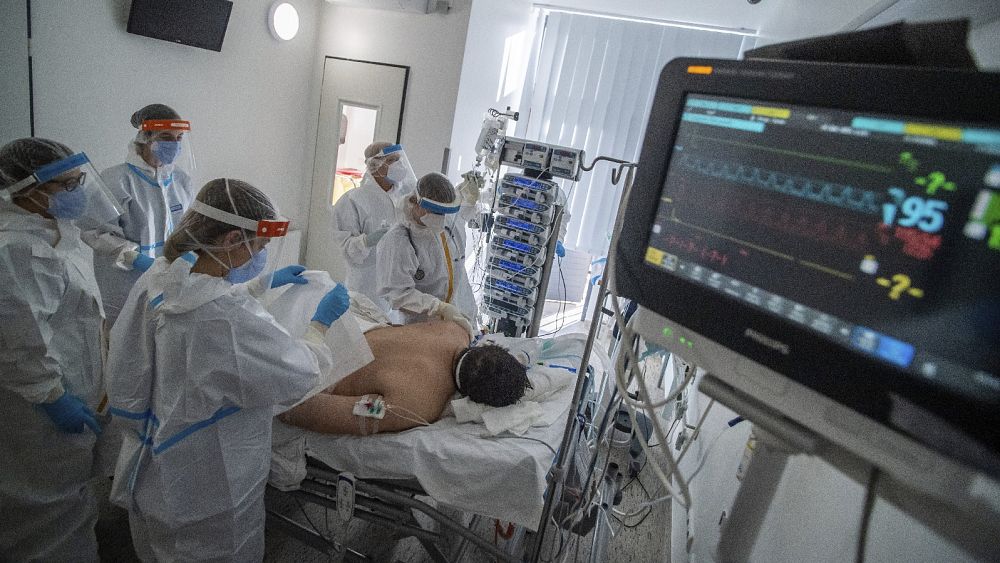Over the past decade, some 8,500 health professionals have left for other European countries. Now Hungary has one of the lowest ratios of doctors per inhabitant in the bloc.
Despite government efforts, Hungarian doctors are leaving the country for better pay and more acceptable working conditions in Western Europe, leaving the country’s healthcare system to deal with understaffed facilities and longer waiting periods.
Over 800 Hungarian doctors requested a certificate to practice outside of the country last year, according to official figures, bringing the total number issued over the past decade to 8,500.
This could lead to a disastrous situation in a country with just over 33,000 doctors for a 9.7 million population, or roughly 3.5 doctors per 1,000 inhabitants — lower than the 3.9 average for the EU.
In 2022, departments of Hungarian hospitals were shut for a total of over 46,000 days. Just over a third of those days (15,000) were blamed on lack of staff, with another 8% (3,729 days) on lack of necessities.
For the National Directorate General for Hospitals (OKFŐ), the country is however not seeing “systemic emigration” of its healthcare professionals.
“Based on the issued certificates – in our opinion – Hungarian healthcare is not at all threatened by the employment of health professionals abroad,” OKFŐ added. The Directorate, which practices state ownership rights at 102 hospitals, added that the number of doctors grew by 10% since 2010.
Best of both world
Yet, according to data by a health insurance company, around 40,000 people were in March 2023 in line for surgical procedures, and waiting times had reached all-time highs.
This staffing problem was exposed with stark consequences during the COVID-19 pandemic, when Hungarian hospitals recorded the second-highest number of deaths in Europe per 100,000 population.
During the global health crisis, Péter Körmendi treated patients in intensive care units both in Hungary and neighbouring Austria. The biggest difference, in his experience, is the patient and nurse ratio. “In Austria, one nurse would take care of one or two patients. In Hungary, there could be 4 or 5 patients.”
Körmendi now works in Wiener Neustadt, Austria, yet maintains a residence in Sopron, Hungary, a town by the border. That, he said, is the best of both worlds: the quality of working in Austria, yet the closeness to his Hungarian family. It would, however, take a “miracle” for him to move back to Hungary full-time.
Körmendi is also an admin of the Facebook group for Hungarian doctors in Austria with over a thousand members – according to him, 70% of them are practicing doctors. The Facebook group for Hungarian doctors working in Germany has over 2,500 members.
“Every day, for six years, three doctors and two nurses have left Hungary,” János Bélteczki, head of the Hungarian Doctors’ Association told The Guardian in 2015. Over 200 doctors moved to the UK in that year.
Germany, Austria, the UK and Sweden, were the most common destinations between 2010-2019, numbers revealed.
Spending on healthcare goes some way to explain this.
In 2020, the government, led by nationalist Prime Minister Viktor Orbán, spent only 7.3% of the GDP on healthcare compared to a 10.9% EU average. The state rolled out an 11% pay rise for healthcare professionals in February 2023, meaning doctors out of the university are now paid a gross of €1,800 per month.
‘A third of what I earned abroad’
But for Réka Osváth, a 25-year-old woman specialising in psychiatry, it isn’t only about the salary. She attended medical university in Hungary, and did a semester abroad in Neukirchen, Austria, where she decided to start her career.
“It was the environment, the hospital itself, the people, the availability of all equipment, that they treat you as human and the salary,” she told Euronews.
Working over 200 hours a month, Osváth lives by the border and spends as much time as she can in Budapest, where her friends and partner live, and where she wants to eventually start a family.
She will soon return home to start training in the city of Vác, she said, “despite the fact that I will earn just a third of what I earned abroad.”
Osváth should qualify as a psychiatrist in five years and hopes to then move on to the private sector, which has increasingly become a refuge for healthcare professionals.
“The largest private institutions now offer a similar work environment and quality as the best Austrian or German private hospitals,” Róbert Lancz, the president of private healthcare group Primus, highlighted. The return of Hungarian doctors who previously worked abroad, like Osváth, “primarily strengthens the medical groups of the market-leading private providers,” Lancz added.
Doktor24, a private healthcare provider co-owned by Lancz, offers a wide range of services for hefty prices: cardiology consultation for €90 and arthroscopic knee surgery starting at €1,000. These prices are often out of reach for the average Hungarian as the median salary is €950 per month. But for knee surgery, patients in state healthcare would have to wait an entire year, according to the March figures.
As the pay in the private sector is more enticing than in state hospitals, the gap between public and private is widening with a relatively small portion of the population being able to access private healthcare. The majority is therefore stuck with overworked professionals, closing units, crumbling walls and record-breaking waiting times.


